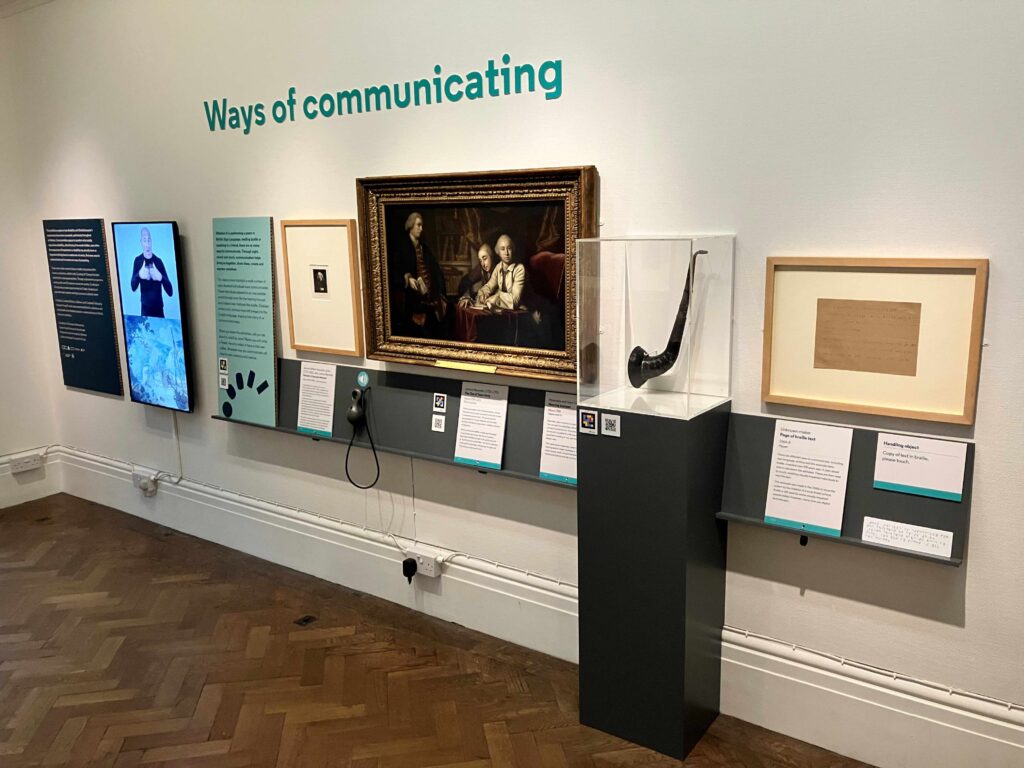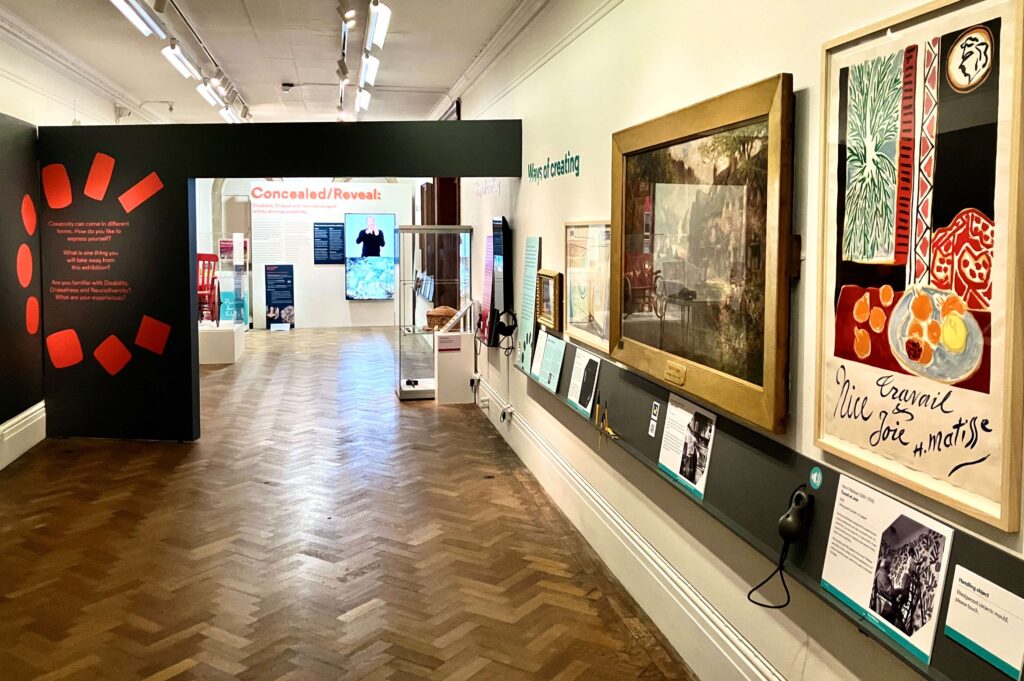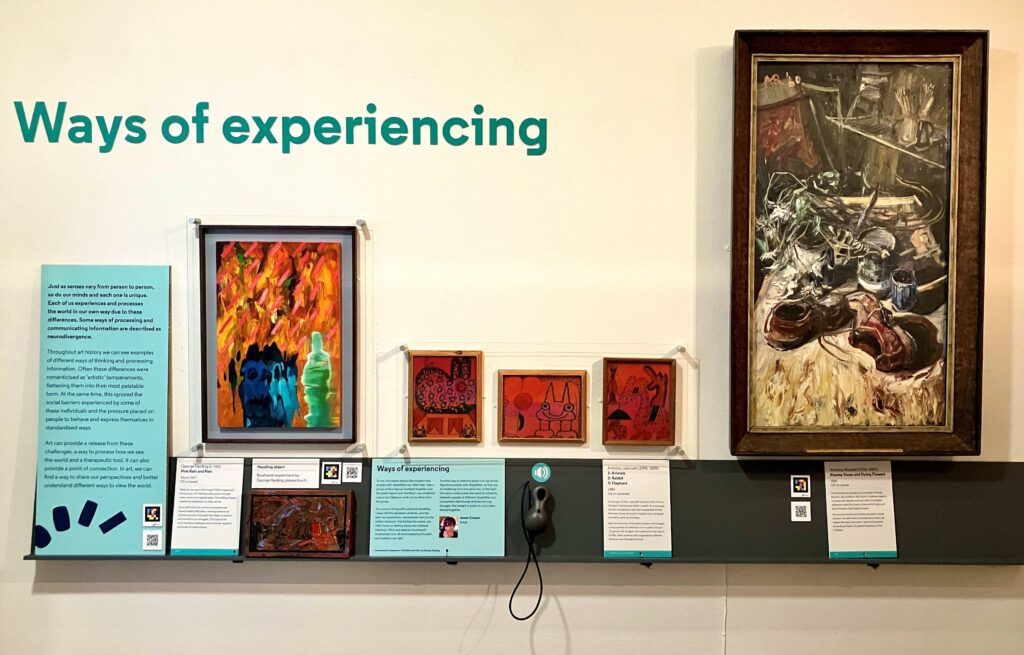The title of this exhibition (which ended on 14 April) was apt, less because of the theme, but more because it was tucked away at the top of the building.
Exploring how disability and disabled people’s experiences have been systematically erased from art history, the exhibition sought to unearth these stories via selected works from the Bristol Museum collection as well as more contemporary voices.
There are two points from which you could enter, which created a curious introductory dynamic. A short panel explained the exhibition’s desire for a polyphony of disabled voices in the museum, in part to redress our misrepresentation and in part to share contemporary narratives. This foundational entry shares ways that disabled people have adapted to an inhospitable and inaccessible world for centuries.
The commitment to multiple modes of interpretation – including a large print guide – was instantly clear. There were several options to access information – written, audio, signed, and sections are mobile for ease of looking and handling.
Impressive, if a little overwhelming, and not entirely consistent (I was unable to watch a conversation between Roo Dhissou and Ashokkumar Mistry due to lack of captions). Another point of note is that the exhibition was hung at a lower height, an accessibility practice slowly working its way into the curatorial canon as disabled curators are provided opportunity to make curatorial decisions.

The exhibition first introduced examples of braille and hearing trumpets as well as some of the individuals who developed and accessed such tools of communication historically.
A portrait shares the history of the 18th-century writer Samuel Johnson (1709-1784), who experienced Tourette’s Syndrome as well as impaired vision and deafness. After his career in teaching was cut short due to prejudice experienced from others, Johnson moved into writing and journalism, to the extent that his work revolutionised the English dictionary as we know it.
A section titled “Interconnected” explored the sensory profile and introduced the unique ways in which we might perceive the world and the direct impact that this has on how we communicate, translate and sense the world. Bilingual Poet’s Dilemma, 2017 (DL Williams, Sandra Alland and Ania Urbanowska) was a brilliant contemporary addition, highlighting the continued frictions in communications, presented by a society that is still largely designed for non-disabled people.
As the exhibition delved deeper it was revealed that many famous artists throughout history, including Henri Matisse (seriously impaired vision towards blindness in later years), Barbara Hepworth (cancer and reduced mobility), JMW Turner (cataracts, impaired vision) and Francisco Goya (deafness) had practices that were transformed by a change in their physical and sometimes psychological experience of the world.
For these artists particularly, their stories only half told due to systemic prejudice, the disabling experiences came later in life. What is revealed here is how their practice changed, how sensory and physical difference does not diminish creativity, possibility, or imagination, but rather enhances, emboldens, and creates new facets to explore.

On the other hand, there are those who’s creativity was a tool of survival throughout their life. One such voice within this legacy is Sarah Biffin, a celebrated miniaturist who taught herself to paint with a paintbrush strapped to her arms and using her mouth.
Initially a fairground performer who went by the stage moniker of “The Limbless Wonder”, she soon received patronage and was able to leave a life spectatorship, providing a living for herself by her own merit and skills.
This relationship to skill, making and craft was explored further through craft trades that disabled people would have undertaken in the 1800s and 1900s to make a living – weaving, woodworking and beading were some of the highly skilled crafts that disabled people would undertake, a complex provision of work that also served as segregation in organisations such as Bristol Guild of the Handicapped and Bristol Royal School and Workshops for the Blind.

Towards the end of the show, I was drawn to the work of Anthony Jadunath, under a section titled “Ways of Experiencing”. Neurodiversity is a relatively new term by which we understand the myriad ways that we might experience the world differently via the pathways of our brain as much as the body itself.
Art has long been defined as a tool to make sense of the world and to draw connections with each other. No less here as we try to make sense of the injustices served throughout history upon those demonised and stigmatised for being “different”.
Although it created something of a cacophony to the already overloaded storyboard of history, the voices of the project co-producers were invaluable insights into how we perceive the unveiling of hidden histories that relate to our own experiences.
I’d like to end with how I began – at the beginning, where an introductory panel declared that there have been disabled artists making beautiful work the world over and throughout history, we just haven’t known the full story. I don’t disagree; however, I had some difficulty making complete sense of this exhibition.
The disparate sections of enquiry, while all important, generated a somewhat incoherent narrative, but perhaps this is emblematic of the wayward, ill-documented history of disabled lives. Concealed/Reveal feels like the tip of the iceberg with some incredible histories explored, perhaps too many for this small tucked away gallery space at the top of a major museum.

As I left, I contemplated the exhibition in the context of the museum, and I wondered why I was so baffled by the location and size of the space.
As I descend the stairs it hits me, how does the work permeate the institution?
Curating for Change is a ground-breaking programme, but to reveal is only the start, change must dig deep, visibility must be tangible not performative. I headed to the shop to find something to read in relation to the exhibition and found nothing.
While there was a notion of our voices in the gallery, what about the rest of the building? It took asking three members of staff to find the exhibition, whose directions I followed purely on lipreading; wayfinding is a form of access and care in the first instance.
My question to the museum is, how does the legacy of these disabled histories carry through?
Hannah Wallis is a co-programme director at Grand Union arts organisation, Birmingham





